Changes in Dentistry over Time: Through the Ages Project Part 5 of 10
- sasa2147
- Aug 14
- 8 min read
By Jacob Lindbert
Introduction
This research paper will serve to outline the key changes in dentistry throughout time, highlighting some of the major time periods and empires within history. The paper will walk through techniques, beliefs surrounding dental care, and provide images of ancient tools and procedures. The progression through time will be as follows: Ancient Egypt, Ancient Greece, Roman Empire, Middle Ages, Renaissance, 18th - 19th century, and lastly modern-day 20th - 21st century dentistry.
Ancient Egypt (3000 BCE – 500 BCE)
In Ancient Egypt, dental care was primarily handled by priests and scribes, representing the close association that ancient societies placed between health and religion. They believed that dental issues were very often the result of spiritual imbalances or supernatural forces that plagued the individual. One example is the famous ‘tooth worms’, which were thought to cause decay in the teeth of individuals, leading to very painful treatments to rid the individual of them. With regards to dental tools and techniques, evidence from mummified remains shows that Egyptians used basic dental tools and herbal remedies to alleviate pain and stabilize teeth. For example, gold wires were used to bind loose teeth to prevent them from falling out (BiologyInsights Team, 2025). Oral infections were treated by various herb and spice mixes, most notably cumin, incense, onion, myrrh, camphor, and cinnamon. They created a tooth cleansing powder made from mint, salt, pepper, and dried iris flowers. The Egyptians also developed breath mints, mixing herbs and spices with honey (San-Aset, 2020). Although innovative, many of the Ancient Egyptian dental practices were basic and not widely effective, with much of the focus on pain management rather than actual prevention or curing of the root problem.
The following is an image of the gold wiring technique used to keep teeth in place by the Ancient Egyptians.
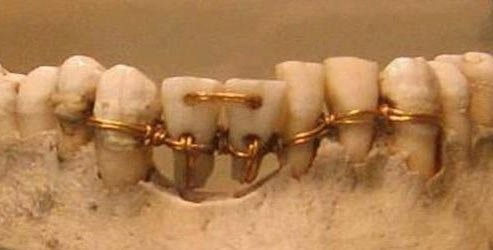
Ancient Greece (800 BCE – 150 BCE)
Ancient Greek philosophers, like Hippocrates and Aristotle, began widely incorporating dentistry into their wider understanding of medicine. Dentists of the time were physicians and philosophers who explored the causes of dental issues. It was widely believed that diseases and dental conditions were connected with imbalances in bodily fluids. Hippocrates, often referred to as the "Father of Medicine," described dental ailments, emphasizing preventive care. He recommended the use of specific herbal remedies to manage oral diseases, highlighting the importance of diet and hygiene in maintaining dental health (Olden Tech Editorial, 2023). This was a period of massive growth in knowledge, with the Greeks spending large amounts of time studying anatomy and the root causes of dental issues. Their exploration into the causes of tooth decay and gum disease fostered a greater understanding and appreciation for oral pathology (Olden Tech Editorial, 2023). With this increase in knowledge, the Greeks performed simple extractions and used gold wires to stabilize teeth, like the Ancient Egyptians did. Additionally, herbs were used to create rinses to clean teeth, soothe pain, and freshen breath. During this period of time, dentistry was not a unique field but integrated into the general medical practice, emphasizing its importance in the greater medical sphere.
An image of some of the dental tools from Ancient Greece. Many are similar to those of the Ancient Egyptians, with similar gold wiring techniques used as well.

Roman Empire (500 BCE – 450 CE)
The Romans continued to advance dental care with the utilization of practical techniques and tools. They relied on barber-surgeons who performed tooth extractions using forceps and used rudimentary fillings to repair cavities. During Ancient Roman times, doctors performed tooth extractions. Dentures were made using boxwood, bone, or ivory. Extractions relied on crude forceps. Based on the Twelve Tables of Roman legislation, we also know that gold was used on teeth during the time (Lentz, 2022). In addition to these techniques, the Romans placed a heavy emphasis on oral hygiene. They created makeshift toothbrushes, toothpaste, mouthwashes, and more. Frayed twigs of aromatic woods like cinnamon and olive were used as toothbrushes; eggshells, pumice, seashells, and more were used to create toothpaste; urine, vinegar, and other mixes were used to create mouthwashes for the Romans to use (Hawryluk, 2023). Like the Ancient Egyptians, the Romans were not focused on identifying the root causes of dental pain and instead were focused on relieving immediate pain and providing functionality. As a result of this, tooth loss was a common issue due to the extensive use of lead in cookware and cosmetics, where teeth were replaced with human or animal teeth using gold or silver wires to keep them in place (Hawryluk, 2023). With the high levels of pain, Ancient Romans turned to Apollonia, the patron saint for those suffering from toothaches (Lentz, 2022). As a whole, the Ancient Roman dental system made several procedural advances in the field, prioritizing pain remedies and immediate treatment plans.
An image of forceps the Roman Empire may have used for tooth extractions:
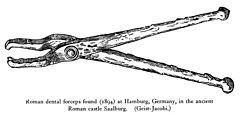
Middle Ages (500 CE – 1500 CE)
During the period of time termed the Middle Ages, dental care saw some regressions as much of the general medical and dental knowledge from earlier civilizations was lost. Dental providers were referred to as ‘barbers’ and made up two different groups, barber-surgeons and lay-barbers. Barber-surgeons were educated and trained to perform complex operations, while lay-barbers would help with more routine services. Like earlier civilizations, dental providers of the time performed extractions and other basic procedures. They were also heavily involved in creating dental hygiene products like tooth powders and chewing sticks. Herbal ingredients played a substantial role in tooth powders, with substances like sage, mint, myrrh, cloves, and cinnamon commonly used. Abrasive components were often added to these tooth powders to aid in the cleaning process, such as crushed shells or ground charcoal. Salt was another key component of tooth powder as it was believed to have antibacterial properties and reduce oral infections (Hodges, 2023). During this time, it was common for barber-surgeons to use methods like cauterization and bloodletting, the latter reflecting the belief that dental issues are a result of bodily imbalances. Lastly, near the end of the Middle Ages, laws began being implemented preventing lay-barbers from practicing complex dental procedures and requiring barber-surgeons to pass examinations.
Here is an image of a medieval toothbrush that is made of bone.
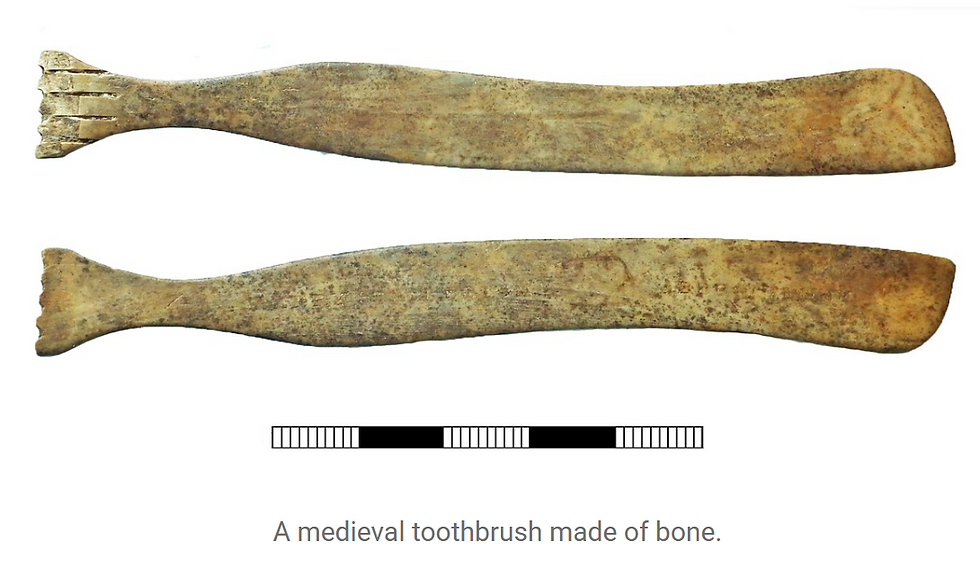
Renaissance (1400 – 1700 CE)
The Renaissance period marked strong growth in scientific inquiry, with dentistry emerging as a distinct discipline. This was a period with many individuals conducting large amounts of research and gaining a deeper understanding of the body and its makeup. The first anatomy books were published during this time with images of each component. Dental care was provided by barber-surgeons, who during this time made strong advancements in tooth replacement and fillings. This marked a significant shift in dentistry, with previous care centered around treating immediate pain while Renaissance providers focused on restoring and replacing damaged or lost teeth. They developed methods for filling teeth plagued with cavities and built early forms of dentures. Additionally, they used and improved tools like the dental pelican, which was used for dental extractions. Overall, this period saw a shift from purely practical treatments to a more scientific approach, though pain management remained basic and yet to be understood.
18th – 19th Century
This period saw the emergence of specialized dentists. After all that was learned during the Renaissance era, dentistry was recognized as a specialized profession. Pierre Fauchard, regarded as ‘The Father of Modern Dentistry,’ introduced complex techniques for treating oral diseases. His contributions include the treatment of tooth decay and the utilization/creation of more advanced dental prosthetics. He took materials like ivory and human teeth to make dentures, fixing them with gold wire and waxed thread (Aksoy et al., 2024). Additionally, he pioneered the invention of cavity fillings using metals, including lead, tin, and gold for dental fillings. He found that removing all traces of caries (tooth decay) before filling in the tooth would strengthen it (Aksoy et al., 2024). This became a cornerstone for modern dentistry and is still a practice followed today. Fauchard also heavily relied on specialized tools like drills and cauterizers to repair, replace, and treat oral problems. Fauchard was among the first to dismiss the idea that worms in teeth caused decay, instead attributing dental caries to acids derived from sugar (Aksoy et al., 2024). His work and others like it during this time greatly revolutionized the way dental care was provided, building the framework for modern dentistry. Another notable discovery of the time was anesthesia, discovered in the 19th century. This allowed for dental procedures to be less painful. Additionally, improved methods of filling cavities and making dentures were created and refined, making them more accessible to the lower/middle classes.
Here is an image of some of the tools Pierre Fauchard would have used in his procedures.
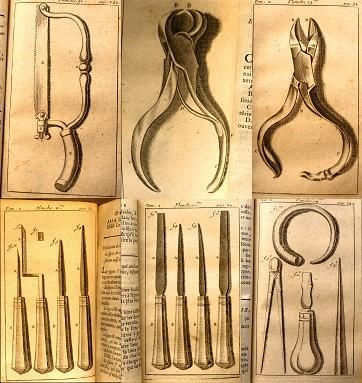
20th – 21st Century
This is the modern day of dentistry, where dentists, orthodontists, and other specialized dentists provide all of the care. One of the major evolutions of the time was the addition of dental X-rays. The first case of using X-rays in dental practices was done by C. Edmund Kells in 1896; however, the widespread use of dental X-rays was not implemented until the late 1950s (Brazdo, 2018). Additionally, fluoride was first added to toothpaste in the 1950s, completely changing the way dental care was performed, reducing cavities significantly (National Institute of Dental and Craniofacial Research, 2000). Crowns, root canals, and braces became standard procedures with the development of materials, including porcelain and resins, which greatly improved dental restorations. With so many new inventions and discoveries made, dental care shifted from pain management to prevention, understanding that dental care plays a role in overall health and well-being. The invention of smart toothbrushes, teeth whitening strips, flossers, and more has allowed for dental hygiene unlike ever before. As dentistry continues to grow and advance, it is expected that technology will continue to play a big part. Dental surgeries can utilize 3D printing, laser technology, and more to provide well-rounded treatments and procedures, yielding a holistic model of care for the patient.
Here is an image of dental X-rays:
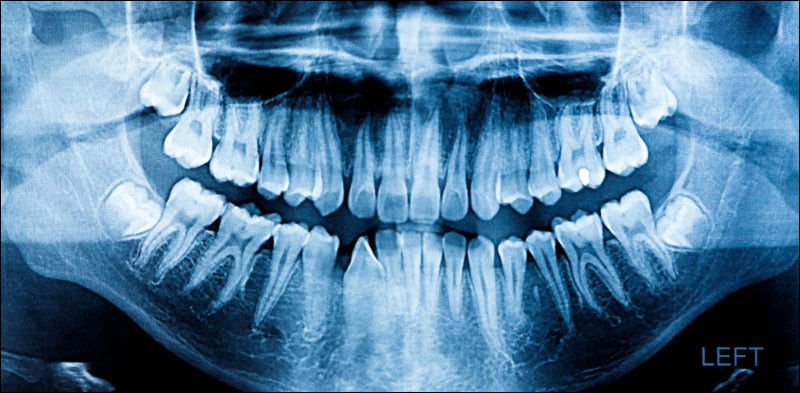
Conclusion
The history of dentistry reflects society's ongoing pursuit of better health. This has evolved from early efforts to prevent pain to the current methods of preventative and restorative care. Reliance on spiritual beliefs shaped early civilizations, with later technological advancements yielding new changes and methods of care. Influential figures like Hippocrates, Pierre Fauchard, and modern pioneers helped shift dental care from a reactive to a proactive practice. As we move into the future, advancements in digital technology, artificial intelligence, and bioengineering are primed to further revolutionize dentistry, making treatments more precise, accessible, and patient-centered.
Sources
Aksoy, U., Aksoy, S., Dilan Kırmızı, & Kaan Orhan. (2024). Pierre Fauchard (1678-1761): Pioneering Dental Surgeon of the Enlightenment Age. Cureus. https://doi.org/10.7759/cureus.69563
BiologyInsights Team. (2025, February 12). Ancient Egyptian Dentistry: Tools, Treatments, and Beliefs. BiologyInsights. https://biologyinsights.com/ancient-egyptian-dentistry-tools-treatments-and-beliefs/
Brazdo, Dr. M. (2018, July 24). The Evolution of Dental X-Rays. Artistic Touch Dentistry; Artistic Touch Dentistry. https://www.artistictouchdentistry.com/general-dentistry/the-evolution-of-dental-x-rays/
Hawryluk, D. A. (2023, August 10). Exploring Ancient Roman Dental Health. St. Lawrence Dentistry. https://www.stlawrencedentistry.com/blog/dental-health/exploring-ancient-roman-dental-health-a-glimpse-into-the-past/
Hodges, P. (2023). Dental Hygiene Practices of the Middle Ages. Medieval Historia. https://doi.org/1025161/74749
Lentz, K. (2022, December 8). A Look Back at Dentistry in Ancient Rome. American Dental. https://atooth.com/a-look-back-at-dentistry-in-ancient-rome/
National Institute of Dental and Craniofacial Research. (2000). The Story of Fluoridation | National Institute of Dental and Craniofacial Research. Nih.gov. https://www.nidcr.nih.gov/health-info/fluoride/the-story-of-fluoridation
Olden Tech Editorial. (2023, July 2). Exploring Ancient Dental Care Practices Throughout History - Olden Tech. The Insurance Universe. https://oldentech.com/ancient-dental-care/
San-Aset. (2020, April 3). Magical Herbal Medicine of the Ancient Egyptians. Iseum Sanctuary. https://iseumsanctuary.com/2020/04/02/magical-herbal-medicine-of-the-ancient-egyptians/


Comments